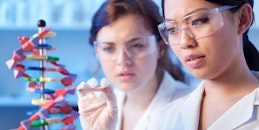Practice Free ATI TEAS 7 Science Test Questions
All products and services featured are independently selected by WikiJob. When you register or purchase through links on this page, we may earn a commission.
- ATI TEAS Science Practice Questions
empty
empty
empty
empty
empty
empty
- Tips for TEAS Science Test Practice
- Final Thoughts
The ATI TEAS (Test of Essential Academic Skills) is a widely used entrance exam for nursing and allied health programs in the US.
Designed to assess your readiness for study at degree level, it covers the key subjects of reading, math, science, and English and language use.
This article looks specifically at the science section of the exam and includes free TEAS science practice test questions to help you prepare.
Prepare for the ATI TEAS 7 Science Test with TestPrep-Online
ATI TEAS Science Practice Questions
ATI TEAS Science Practice Questions: Human Anatomy and Physiology
This is typically the most substantial part of the science test. TEAS Science questions in this section assess your knowledge of the human body and its systems, such as the circulatory, respiratory, nervous, and musculoskeletal systems.
You'll need to understand organ functions, body structures, and the relationships between different physiological processes.
1. During a prolonged period of strenuous exercise, muscles might experience oxygen debt. Which physiological process occurs during this period, and how is it related to muscle fatigue?
a) Glycolysis in the absence of oxygen, leading to lactic acid accumulation
b) Increased oxygen consumption, promoting aerobic respiration
c) Activation of the parasympathetic nervous system, reducing muscle tension
d) Elevated levels of acetylcholine, prolonging muscle contraction
2. Which hormone, released by the adrenal cortex, plays a vital role in regulating electrolyte balance, particularly by promoting sodium retention and potassium excretion?
a) Cortisol
b) Aldosterone
c) Epinephrine
d) Insulin
3. Which blood vessels carry oxygen-depleted blood back to the heart?
a) Arteries
b) Veins
c) Capillaries
d) Arterioles
4. What is the primary function of the respiratory system?
a) To transport nutrients to the body's cells
b) To remove waste products from the body
c) To deliver oxygen to and expel carbon dioxide from the body
d) To regulate the body's temperature

If you want 12-month access to all the practice resources for this test, our partner TestPrep-Online.com offers a Family Membership.
Family Membership gives you access to all the TestPrep-Online resources for the next 12 months. You will also get two separate accounts, which can be very helpful if you have two children preparing for their tests.
Get a Family Membership with 12-Month Access
1. Which organelle is responsible for the synthesis of proteins that are either secreted from the cell or incorporated into the cell membrane?
a) Endoplasmic reticulum
b) Ribosome
c) Golgi apparatus
d) Lysosome
2. In which phase of the cell cycle does DNA replication occur?
a) G1 phase
b) S phase
c) G2 phase
d) M phase
1. Which of the following is an example of a chemical reaction that involves a transfer of electrons?
a) Dissolving salt in water
b) Burning wood
c) Mixing oil and water
d) Melting ice
2. An atom of which element is most likely to form a positive ion (cation)?
a) Chlorine (Cl)
b) Oxygen (O)
c) Sodium (Na)
d) Fluorine (F)
Life and Physical Sciences
This section covers basic biology and chemistry. In biology, you might encounter questions on cell structure, basic genetic concepts, and general principles of evolution and ecology.
The chemistry questions often focus on fundamental principles such as the properties of water, states of matter, basic chemical reactions, and understanding of atoms and molecules.
1. What type of bond is formed when two atoms share electrons?
a) Ionic bond
b) Covalent bond
c) Hydrogen bond
d) Metallic bond
1. What is the basic unit of life?
a) An atom
b) A molecule
c) A cell
d) An organ
1. A scientist is conducting an experiment to test the effect of different temperatures on the rate of enzyme activity. What would be a suitable control group in this experiment?
a) Enzymes at the highest temperature
b) Enzymes at room temperature
c) Enzymes without any temperature manipulation
d) Enzymes at the lowest temperature
2. If a scientific study reports a correlation between two variables, what can be concluded about causation?
a) There is a causal relationship between the variables
b) Correlation implies causation
c) The study is flawed, because correlation cannot imply causation
d) More research is needed to determine causation
1. A study finds that people who eat more fruits and vegetables tend to have lower rates of heart disease.
Which of the following is the best hypothesis for this observation?
a) Eating meat causes heart disease
b) Fruits and vegetables cause heart disease
c) Eating fruits and vegetables reduces the risk of heart disease
d) Heart disease causes reduced consumption of fruits and vegetables
2. In an experiment, plants are grown under different colors of light. The height of the plants is measured after two weeks.
What is the independent variable in this experiment?
a) The height of the plants
b) The color of the light
c) The type of plants
d) The time duration of the experiment
Earth and Physical Science
Though not always as emphasized as the other sections, this part can include questions on basic physics concepts, astronomy, geology, and meteorology.
The focus is generally on fundamental concepts that are relevant to understanding the natural world and physical phenomena.
1. Which layer of the Earth is composed primarily of solid rock and includes both the crust and the upper part of the mantle?
a) Core
b) Mantle
c) Lithosphere
d) Asthenosphere
2. Which of the following best describes the process of evaporation?
a) The change of a liquid into a gas at temperatures below the boiling point
b) The solidification of a liquid as it cools
c) The process of a gas turning into a liquid
d) The combination of hydrogen and oxygen to form water
Tips for TEAS Science Test Practice
Step 1. Master the Basics
Brush up on foundational concepts in human anatomy, physiology, biology, and chemistry.
Strengthen your understanding of key systems and principles that form the core of the TEAS science section.
Step 2. Practice Data Interpretation
Enhance your skills in interpreting graphs and scientific data. Many TEAS science questions require effective analysis of information, so regular practice with data-driven questions is essential.
Step 3. Use Quality Materials
Seek out TEAS 7 science practice test questions from reliable sources.
These resources will be specifically designed to align with the exam's content and format, ensuring accurate preparation.
Step 4. Take Full Length Practice Tests
Assess your overall readiness by periodically taking a full-length ATI science practice test.
This will also increase your familiarity with the pacing of the exam and help identify specific areas for improvement.
You can find a practice test at JobTestPrep.
Step 5. Identify Your Weaknesses
Pay attention to challenging topics or question types where you consistently struggle. Seek additional resources to reinforce your understanding and address weaknesses effectively.
Step 6. Understand How the Test Is Scored
Familiarize yourself with the TEAS scoring system.
Doing so will help you understand your current performance compared to what is expected and assess your progress over time.
Final Thoughts
The science section of the ATI TEAS 7 is considered by many as the hardest part of the exam, so solid preparation is essential if you hope to achieve a high score.
By using ATI TEAS science practice questions and sample papers you can reinforce key concepts, master test taking strategies, and boost your confidence before your official test day.


